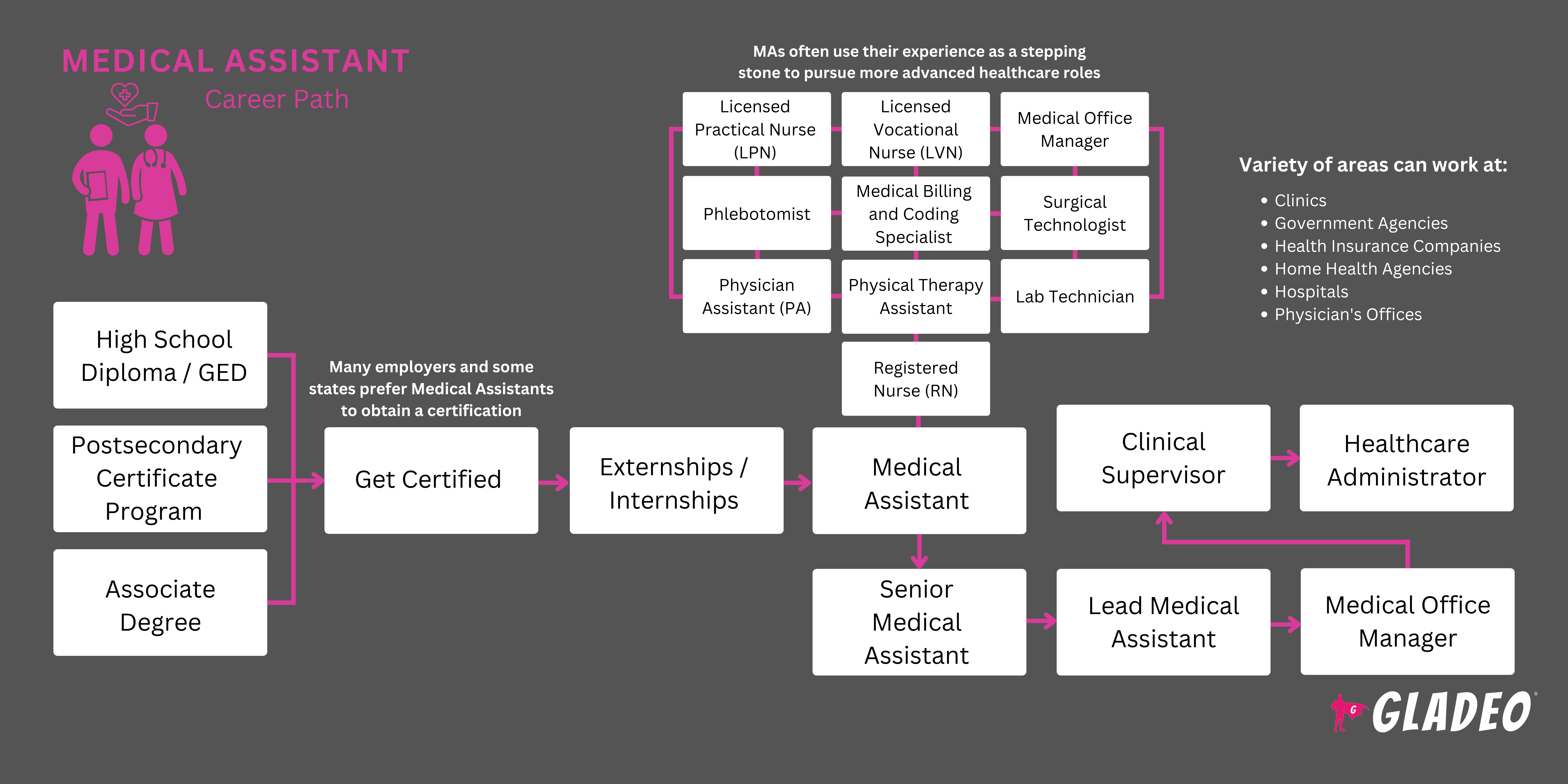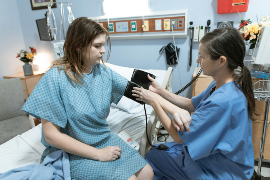Mga spotlight
Certified Medical Assistant (CMA), Chiropractor Assistant, Clinical Medical Assistant, Doctor's Assistant, Health Assistant, Ophthalmic Assistant, Ophthalmological Assistant, Optometric Assistant, Outpatient Surgery Assistant, Registered Medical Assistant (RMA), Patient Care Technician
Healthcare facilities must work efficiently to treat as many patients as possible while giving each patient the time and attention they need. That’s why Medical Assistants (MAs) are brought in to help manage tasks and keep processes moving along.
Medical Assistants work with other healthcare team members in almost any setting, from private clinics and hospitals to outpatient care centers. Many undergo extra training to specialize in areas such as podiatry, ophthalmology, or cardiology, among others.
Some focus on administrative tasks like making appointments, processing insurance claims, and maintaining records. Others perform clinical work like reviewing medical histories, taking vital signs, drawing blood, or giving medications, depending on their training and authorization.
With nearly a million projected employment opportunities by 2033, the Medical Assistant occupation should be a hot career field for years to come!
- Helping patients during medical visits
- Being part of professional healthcare teams
- High demand for workers in a variety of settings
- Opportunities for specialization and career advancement
Oras ng trabaho
Medical Assistants may work part-time or full-time. Shifts can include nights, weekends, or holidays.
Mga Karaniwang Tungkulin
- Schedule patient appointments and follow up with reminder calls or instructions.
- Prepare exam rooms. Ensure they are clean, organized, and stocked with supplies. Sterilize instruments and equipment.
- Check patients in for appointments, verify insurance coverage, and update records.
- Record patient medical history and vital signs, such as blood pressure, temperature, and weight.
- Prepare patients for exams, ensuring they are ready to see their doctor.
- Assist physicians as needed during exams and minor procedures like removing sutures or applying dressings.
- Administer injections and medications, under supervision and as directed.
- Draw blood samples. Follow protocols for safe handling and labeling.
- Perform basic lab tests, such as urinalysis or blood glucose monitoring.
- Go over treatment plans and medication instructions with patients or their caretakers.
Karagdagang Pananagutan
- Answer phones and reply to emails or other messages.
- Relay patient concerns to other healthcare team members.
- Manage inventories and reorder supplies, as needed.
- Maintain patient confidentiality and safeguard records.
Soft Skills
- Ugaling pag-aalaga
- pakikiramay
- Katatagan
- pagiging maaasahan
- Mabusisi pagdating sa detalye
- Empatiya
- Mga kasanayan sa interpersonal
- mapagmasid
- pasensya
- pagiging maaasahan
- May kamalayan sa kaligtasan
- Mukhang makatarungan
- Malakas na kasanayan sa komunikasyon
- Pagtutulungan at pagtutulungan
Teknikal na kasanayan
- Knowledge of common medical conditions
- Managing appointment scheduling software
- Documenting and maintaining patient records using electronic medical records systems
- Taking and recording vital signs (blood pressure, heart rate, temperature)
- Administering medications under supervision
- Drawing blood and performing basic lab tests
- Assisting in minor surgical procedures and wound care
- Performing electrocardiograms
- Familiarity with hygiene, sterilization practices, and infection control
- Mga ospital
- Long-term care settings
- Mga sentro ng outpatient
- Mga opisina ng manggagamot
- Mga sentro ng rehabilitasyon
- Mga pasilidad ng espesyal na pangangalaga
- Mga departamento ng therapy
- Urgent care facilities
Medical Assistants provide vital support to healthcare teams across various settings. They assist with important administrative and clinical tasks, ensuring patients get the care they need in a timely manner.
MAs often assist patients with chronic illnesses or disabilities, providing hands-on support that can be both physically and emotionally demanding. A typical day might involve assisting with procedures, administering medications, taking vital signs, and helping with mobility exercises. These responsibilities require organizational skills and the ability to stay calm under pressure, especially when patients don’t feel well or get upset.
MAs potentially need to work nights, weekends, and holidays, depending on their work setting. Balancing these demanding shifts with personal life can be difficult, and finding time for self-care is crucial to avoid burnout.
The healthcare sector, particularly in outpatient and long-term care settings, is experiencing a growing demand for MAs. This increase is partially due to people living longer and needing more services to manage chronic conditions. At the same time, thousands of healthcare professionals are retiring, leaving several gaps to fill. That’s why so many organizations are turning to MAs to fill those gaps.
Online educational programs are expanding to make MA training more flexible and accessible for workers wanting to enter the field. However, students must be careful to ensure that programs meet accreditation requirements.
The high demand for MAs is leading to longer hours, more patients, and greater responsibilities for those currently working. That’s why MAs must take good care of their mental and physical well-being to avoid job burnout.
MAs may have had an early interest in healthcare — or simply in helping others! They might have been caregivers for family members, seeing firsthand how important it is to support those who need it.
Kailangan ang Edukasyon
- Medical Assistants need a high school degree or equivalent and typically complete a postsecondary certificate program or associate degree at a vocational school or community college.
- Kasama sa mga karaniwang paksa ng kurso ang:
- Anatomy and physiology
- Clinical procedures
- Medical law and ethics
- Medikal na terminolohiya
- Patient care techniques
- Phlebotomy and EKG
- New workers typically receive a fair amount of On-the-Job training after they start.
- Larger employers may offer apprenticeships or in-house Medical Assistant training.
- Many employers and some states prefer Medical Assistants to obtain a certification such as:
- American Association of Medical Assistants - Certified Medical Assistant
- American Medical Technologists - Registered Medical Assistant
- National Healthcareer Association - Certified Clinical Medical Assistant
- National Center for Competency Training - National Certified Medical Assistant
🗸 Note, some certification organizations require applicants to graduate from programs accredited by the Commission on Accreditation of Allied Health Education Programs or the Accrediting Bureau of Health Education Schools.
- MAs often use their experience as a stepping stone to pursue more advanced healthcare roles, such as:
- Registered Nurse (RN)
- Licensed Practical Nurse (LPN)
- Licensed Vocational Nurse (LVN)
- Medical Office Manager
- Phlebotomist
- Medical Billing and Coding Specialist
- Surgical Technologist
- Physician Assistant (PA)
- Katulong sa Physical Therapy
- Tekniko ng laboratoryo
- Training programs are available at community colleges, vocational/technical schools, and some high school programs.
- It’s recommended that MA programs be accredited by the Commission on Accreditation of Allied Health Education Programs (CAAHEP) or the Accrediting Bureau of Health Education Schools (ABHES).
- Review the requirements for the state you plan to work for.
- Isaalang-alang ang mga gastos sa pagtuturo (mga rate sa loob ng estado/sa labas ng estado), mga diskwento, mga scholarship, at mga opsyon sa paghahatid ng kurso (sa campus, online, o hybrid na programa).
- Review the available options for hands-on practicum at local healthcare facilities.
- Think about the duration of the program and the flexibility of class schedules, especially if balancing other commitments.
- Review faculty bios and awards. Learn about graduation rates, certification exam pass rates, and job placement stats.
- Check out the accomplishments of the alumni network!
- Volunteer in healthcare settings to get experience and pick up practical skills.
- Take classes in high school related to anatomy, physiology, biology, health sciences, first aid, math, and English.
- Participate in school activities where you can develop administrative skills.
- Seek part-time jobs in healthcare environments such as clinics, hospitals, or nursing homes to build hands-on experience and improve your people skills.
- Get CPR and Basic Life Support certification to enhance your credentials and boost your emergency response capabilities.
- Join pre-med or health-related student organizations to network with peers and professionals in the healthcare field.
- Explore scholarships or financial aid programs for students pursuing medical careers.
- Attend career fairs or job expos that focus on healthcare careers.
Take advantage of any school programs that offer internships in healthcare settings. - Learn medical terminology to familiarize yourself with the language.
- Research state or potential employer requirements for becoming a Medical Assistant.
- Keep in mind that you may have to pass a criminal background check or drug screening.
- Request to do an informational interview with a working Medical Assistant to learn about their daily duties.
- Check out Medical Assisting Today magazine and online articles and videos about the career field, the settings you could work in, and certifications to pursue.
- Maintain a list of contacts (with phone numbers or emails) who might serve as future job references. Ask their permission before giving out their information, though.
- Keep a working draft of your resume and update it as you gain experience.

- Complete an accredited training program and consider getting certified as a Certified Medical Assistant, Registered Medical Assistant, Certified Clinical Medical Assistant, or National Certified Medical Assistant.
- Talk to your school’s program manager or career center about job placement assistance.
- Upload your resume to job search engines like Indeed.com. Also, check out healthcare-specific job boards like the National Healthcareer Association.
- Network with healthcare professionals and attend industry job fairs.
- Advertise yourself on LinkedIn. Keep your social media professional, as potential employers often screen candidates’ online activities.
- Update your resume with keywords like:
- Administrative skills
- Clinical support
- EMR systems
- Medical procedures
- Pag-aaruga sa pasyente
- Vital signs
- Check out Medical Assistant resume examples for ideas on formatting, phrasing, and keywords to use.
- Review common interview questions and do mock interviews to practice your responses.
- Do some research about the employer before going to interviews. Read about their mission and values.
- Brush up on terminology and current events related to the industry.
- Dress professionally for interviews.
- Discuss your career goals with your supervisor. Ask for their guidance, mentorship, and feedback on areas for improvement.
- Pursue additional certifications. Specializing in high-demand areas like ophthalmology and podiatry.
- Engage with patients in a compassionate but professional manner. Build your reputation as someone who cares and does the job right.
- Study employer policies and procedures to become more efficient and trusted.
- Become a subject matter expert on the equipment and software you use.
- Maintain strict hygiene and sanitation protocols to promote safety in healthcare settings.
- Foster connections with physicians, nurses, and other healthcare team members.
- Regularly read medical journals, and blogs, or attend webinars on the latest in healthcare practices.
- Take advantage of continuing education courses and workshops to stay current on industry developments.
- Volunteer to lead meetings, train new hires, or organize patient care initiatives.
- Consider training for advanced roles such as an office manager, healthcare administrator, or supervisory positions in larger medical practices.
- Join and participate in professional organizations like the American Association of Medical Assistants.
- Track your performance and accomplishments by keeping a record of patient feedback, efficiency improvements, and examples of problem-solving to show during performance reviews.
- Seek out mentorship within and outside of your workplace to gain insights from experienced professionals.
- Cross-train in different departments or specialties to increase your versatility.
- Consider earning a bachelor’s degree in healthcare administration if you’re interested in moving into management.
- Advocate for patients and ensure they understand their care plans.
- Relocate to an area with more opportunities, if needed.
Mga website
- Accreditation Bureau of Health Education Schools
- American Association of Medical Assistants
- American Medical Certification Association
- Mga American Medical Technologist
- Commission on Accreditation ng Allied Health Education Programs
- MedicalAssistantSchools.com
- National Center for Competency Testing
- National Healthcareer Association
Mga libro
- Kinn’s The Medical Assistant: An Applied Learning Approach, by Brigitte Niedzwiecki RN MSN RMA and Julie Pepper BS CMA
- CMA Study Guide 2024-2025: Complete AAMA Review, by Newstone Test Prep
- Medical Terminology: The Best and Most Effective Way to Memorize, Pronounce and Understand Medical Terms, by S. Meloni M.D. and M. Mastenbjörk M.D.
MAs are critical members of the healthcare profession, but the salary isn’t as high as some other medical careers. For students interested in related pathways, options include:
- Dental Assistant
- Health Information Technician
- Home Health o Personal Care Aide
- Licensed Practical and Vocational Nurse
- Licensed Practical Nurse (LPN)
- Medical Billing and Coding Specialist
- Espesyalista sa Medical Records
- Nurse Midwife
- Nursing Assistant and Orderly
- Nutritionist
- Occupational Therapy Assistant and Aide
- Assistant sa Optometrist
- Personal Fitness Trainer
- Technician ng Pharmacy
- Phlebotomist
- Katulong sa Physical Therapy
- Katulong ng Manggagamot
- Registered Nurse (RN)
- Veterinarian Assistant
Newsfeed

Mga Tampok na Trabaho

Mga Online na Kurso at Tool








